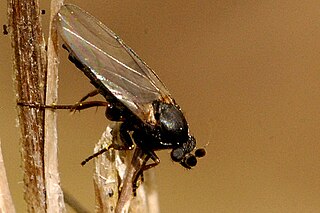
The Metopininae are a subfamily of flies in the family Phoridae.

Phorinae is a subfamily of flies in the family Phoridae. There are at least 90 described species in Phorinae.

Pseudacteon is a genus of flies in the family Phoridae. There are over 70 described species of Pseudacteon fly. They are also known as ant-decapitating flies due to their parasitic larval stage. An egg is injected by the female fly into the shoulder joint of an ant worker. Soon after, the egg undergoes rapid inflation as it appears to absorb ant hemolymph. This first instar larva migrates into the ant head and consumes the jaw muscle and other tissues, leaving the mandibles hanging and preparing a future exit space. After about two weeks, the ant worker is termed a "zombie" because the fly larva has effectively taken control. The worker leaves the nest and dies in the leaf litter or in a crack in the soil. As it dies, the ant's head falls off, apparently because the fly larva releases an enzyme that dissolves the membrane attaching the ant's head to its body. The fly pupates in the detached head capsule, requiring a further two weeks before emerging through the ant's mouth. In tropical, subtropical areas the flies are active all year round, but in temperate regions they are active during all months except the winter months. Several Pseudacteon species were deliberately introduced to the United States to combat via biological control the invasive fire ant species Solenopsis invicta.

Gymnophora is a genus of scuttle flies. There are at least 60 described species in Gymnophora.

Phalacrotophora is a genus of scuttle flies. There are at least 50 described species in Phalacrotophora.
Beckerina is a genus of flies in the family Phoridae.

The Metopininae is a tribe of flies in the family Phoridae.
Acanthophorides is a genus of flies in the family Phoridae.
Chonocephalus is a genus of flies in the family Phoridae.
Cremersia is a genus of flies in the family Phoridae.
Diocophora is a genus of flies in the family Phoridae.
Menozziola is a genus of flies in the family Phoridae.
Metopina is a genus of flies in the family Phoridae.
Microselia is a genus of flies in the family Phoridae.
Pericyclocera is a genus of flies in the family Phoridae.
Trophithauma is a genus of flies in the family Phoridae.
Xanionotum is a genus of flies in the family Phoridae.

Aenigmatias is a genus of flies in the family Phoridae.





